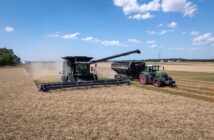Yield is usually king when it comes to driving down cereals costs of production.
Huntingdon Monitor Farm host Russell McKenzie, however, has driven his winter feed wheat costs of production down by £12/t over the last three years despite a 1.73t/ha decrease in yield.
AHDB Monitor Farms bring together farmers who wish to improve their businesses by sharing performance information and best practice around a nationwide network of over 30 host farms. Monitor Farms are part of AHDB’s wider Farm Excellence Platform, which works with the industry to improve performance through knowledge exchange and benchmarking.
At his last Monitor Farm meeting Russell explained that his total cost of production for first winter feed wheat was now down to £96/t.
He has achieved this decrease primarily through changing his machinery policy.
Russell said: “We now have less machinery and do more direct drilling so hope to use the machinery less. This will help to make savings in time and fuel and also to extend the life of the machinery.
“When we changed combine, we bought a used machine, so we also won’t have as big a hit on depreciation.”
Teresa Meadows, AHDB Cereals & Oilseeds Knowledge Exchange Manager, said: “Machinery depreciation and repairs are often one of the largest fixed costs when calculating the cost of production and this has been one of the areas of focus for Russell through benchmarking and during his time as a monitor farmer.”
AHDB Monitor Farm groups from harvest 2017 will be benchmarking using the new Farmbench programme, which for the first time allows farmers to enter whole farm costs.
Russell’s cost of production per tonne for winter feed wheat for the last three years:
| Harvest | 2014 | 2015 | 2016 |
| Yield (t/ha) | 12.28 | 12.85 | 10.55 |
| Total variable costs (£/t) | 47 | 37 | 46 |
| Total fixed costs (£/t) | 62 | 70 | 51 |
| Total costs (£/t) | 108 | 107 | 96 |
Machinery changes between 2014 and 2017:
- Had two combines – now has one
- Had two sprayers – now has one
- Had five main working tractors – now has three.
Russell added: “The Monitor Farm programme made us sit back and review what we’re doing. It made us look more closely and analyse our business in detail.
“That’s where the benchmarking really helps. You can compare costs in specific areas. We realised that we didn’t need to be overburdened with lots of machinery.”
Russell has also taken on more contracting work to further spread the labour and machinery costs.
Reflecting on the Monitor Farm programme, Russell said: “I hope people see it as a unique forum for discussing cutting edge, nitty gritty sides of the business that you can’t get from going to any other meetings.”
Russell hopes to continue with this mindset going forwards: “For our own farm, we hope we can keep on improving and not stand still. We want to stay ahead of the curve with varieties too – trying to stay at the forefront of innovation.”
Find out more about your local Monitor Farm by visiting cereals.ahdb.org.uk/monitorfarms




